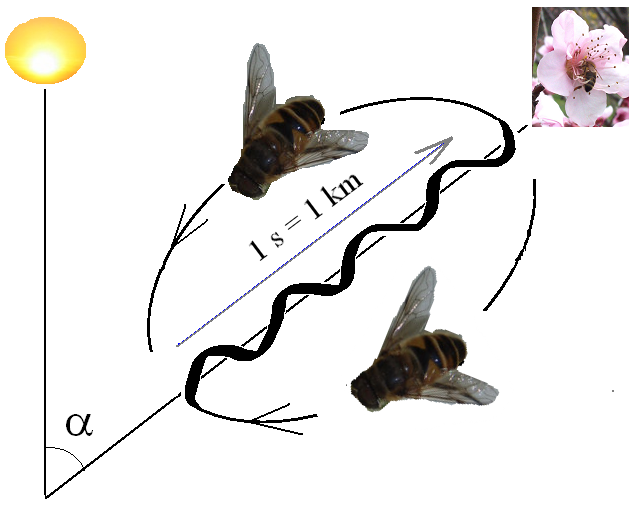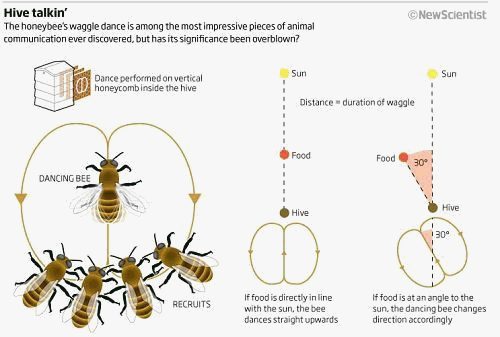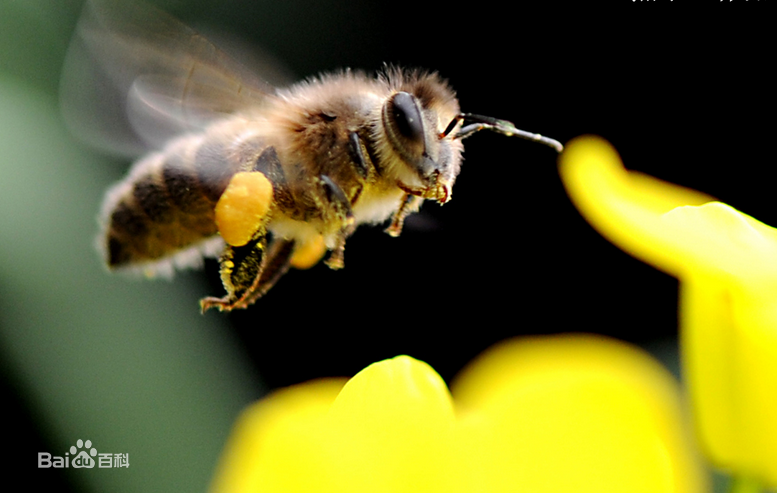
作者:武汉新航道北美考试院 托福听力组 徐杉
在2019年11月9日下午场的托福考试中出现了关于waggle dance(蜜蜂八字形摇摆舞)的生物类讲座文章,作为动物交流中影响比较重要的一种交流方式,本期学科知识为同学们带来waggle dance及集群智慧的相关背景,
一.知识背景补充
蜜蜂舞蹈(英语:waggle dance,蜜蜂八字形摇摆舞)为用于表达蜜蜂养殖行为中之蜜蜂特定八字形舞蹈(figure-eight dance)的一个术语。通过进行这个舞蹈,成功觅食者可以与群体的其他成员分享有关产生花蜜和花粉的花,水源,或以新的巢址位置的方向和距离的信息。出自于奥地利生物学家和诺贝尔奖得主卡尔·冯·弗里希在1940年代的研究翻译其意义,工蜂在採完花蜜回到蜂巢之后,会进行两种特别的移动方式。研究对象是一种西方蜜蜂、为卡尼鄂拉蜂。当一隻工蜂回到巢中,其他工蜂会面向她,并以她为中心,就像在观看这隻蜜蜂跳舞一样。

舞蹈的种类包括摇臀舞和环绕舞。摇臀舞是指蜜蜂跳舞的移动路径会形成一个8字形。外围环状部分称做回归区(return phase);中间直线部分称做摇臀区(waggle phase),摇臀舞(Waggle dance)因此得名。蜜蜂会一边摇动臀部一边走过这条直线,摇臀的持续时间表示食物的距离,摇臀时间愈长,表示食物距离愈远,以75毫秒代表100公尺。而这段直线与地心引力的方向之夹角,代表食物方向与太阳方向的夹角。之后更发现,蜜蜂会因太阳位置的相对移动而修正直线的角度。
环绕舞(Round dance),是工蜂用来表达蜂巢附近有食物的存在,但无法表达食物的距离与方向。通常使用在发现近距离的食物(距离小于50-60公尺)。然而后来的研究认为环绕舞并非独立存在,而是摇臀舞的直线部分极短暂的版本。
托福阅读中曾经在经典加试中也有类似的文章,标题为蜜蜂的沟通模式,文章如下:
Flowers provide food for bees. The bees collect tiny grains of pollen and a sweet liquid called nectar from the blossoms they visit. They make honey from the nectar, and use both honey and pollen as food. During their food-gathering flights, bees spread pollen from one flower to another, thus pollinating (fertilizing) the plants they visit. This enables the plants to reproduce.
The honey bee colony
A typical honey bee colony is made up of one queen, tens of thousands of workers, and a few hundred drones雄蜂. Honey bees live in hives. The hive is a storage space, such as a hollow空的 tree or a box, which contains a honeycomb蜂窝. The honeycomb is a mass of six-sided compartments隔间 called cells. Worker bees build the honeycomb of wax produced by their bodies. The wax oozes渗出 through small pores (holes) in the body and forms tiny white flakes on the outside of the abdomen. They also collect a sticky substance bee glue, from certain kinds of trees.
The body of the honey bee
A bee has five eyes-three small ones that form a triangle on top of its head, and a large compound eye on each side of its head. Honey bees were the first insects known to be able to distinguish colors. Bees have three kinds of color-sensitive cells in their eyes. These visual cells are especially sensitive to blue, yellow, and ultraviolet rays, which humans cannot see. The sting of a worker bee is straight, with barbs (hooks) on it. When the bee thrusts the sting into flesh, the barbs hold tight, and the stinger蛰针 pulls out of the bee's body.
这篇文章讲小蜜蜂,分为 honeybee和worker bee。讲了honeybee是怎么寻找蜜源和如何告訴同伴蜜源的位置的。开头先說蜜蜂和termite白蚁与很多species 不同,他們是 social。蜜蜂是一個是由社会分工合作的动物,交流因此就变得很重要。然后科学家們就开始用他們的聪明才智研究小蜜蜂了。开始以为是honeybee是靠scent交流,然后某德国科学家研究发现scout 用舞蹈來告訴工蜂蜜源的远近,远的用八字舞,近的用圆圈舞。他因此获得炸药奖。交流的內容靠跳八字舞或者circle 区别distance,而不是食物的类别。原來发现蜜蜂找到窝以后跳舞是指示food type,后来发现more than that。跳舞还指示出了direction and distance。跳舞分两种种nectar花蜜dance 另一種 pollen花粉dance,有一道題問這個的,nectar是跳圓圈舞,pollen是跳八字舞。但是一直有科学家怀疑這個說法直到 1989 年,一些科學家为了验证他的理论做了machine bees 模仿scout,就是不去有食物处,发现robot使用這些动作果然可以向工蜂有效传递资讯。采蜜只是跳舞來做一些指示。最后发現了小蜜蜂带回來的资讯和wind 无关。
二、考情回顾和真题解析
1. 2019年11月9日下午场生物类讲座,考情回顾如下:
蜜蜂的摇摆舞(waggle dance),和跳舞的原因。当他们返回蜂巢时,它们用头碰撞正在表演的“摇摆舞”的蜂巢伙伴。摇摆舞是用来指示可能的觅食者去往丰富的花蜜源的。这是典型的利他主义。
2. 2017年10月21日生物类讲座,考情回顾如下:

swarm intelligence就是用蜜蜂的群体来运用群体合作来 locate food or habitat个现象是,蜜蜂一旦发现实物就会跳两种舞,其中一种是waggle dance,另一种是round dance关键是跳哪一种是跟食物的距离有关,分界线是100米。接着是一个实验,就是一个教授把一群蜜蜂放在一个岛上这个岛有两个特点,一是很小,基本没有自然栖息地给蜜蜂居住;二是教授在岛上安置了5个蜂巢,只有一个是optimal的,所以就看他们怎么互相协助来化选然后这些蜜蜂也是非常聪明的找到了化的蜂,过程非常有趣,因为其实一部分蜜蜂(不是全体蜜蜂)会通过在哪一个蜂集周围跳舞(还是环绕)来投票,投票最多的就会是群体的最终选择,而最后也证实,他们的选择就是最optimal的哪一个。
3. 真题中TPO46 L2 swarm intelligence这一篇也讲到集群智能,参考解析如下:
Listen to part of a lecture in a biology class.
I'd like to continue our discussion of animal behavior and start off today's class by focusing on a concept we haven't yet touched upon—swarm intelligence. Swarm intelligence is a collective behavior that emerges from a group of animals, like a colony of termites, a school of fish, or a flock of birds.
开门见山直接引入群体智能这一概念,指的是一种出现在一群动物中的集体行为。
Let's first consider the principles behind swarm intelligence, and we'll use the ant as our model. Now, an ant on its own is not that smart. When you have a group of ants, however, there you have efficiency in action. You see, there's no leader running an ant colony. Each individual, each individual ant operates by instinctively following a simple set of rules when foraging for food. Rule number 1: Deposit a chemical marker... called a pheromone. And rule 2: Follow the strongest pheromone path. The strongest pheromone path is advantageous to ants seeking food. So, for example, when ants leave the nest, they deposit a pheromone trail along the route they take. If they find food, they return to the nest on the same path and the pheromone trail gets stronger—it's doubled in strength. Because an ant that took a shorter path returns first, its pheromone trail is stronger, and other ants will follow it, according to rule 2. And as more ants travel that path, the pheromone trail gets even stronger. So, what's happening here? Each ant follows two very basic rules, and each ant acts on information it finds in its immediate local environment. And it's important to note: Even though none of the individual ants is aware of the bigger plan, they collectively choose the shortest path between the nest and a food source because it's the most reinforced path.
以蚂蚁为例探索群体智能背后的一些原则:规则一:留下一种叫做费洛蒙的化学标志。规则二:沿着费洛蒙最强烈的那条路走。虽然没有任何一只蚂蚁意识到了更大的计划,但它们集体选择了蚁巢和食物之间最短的路,因为这是痕迹最强的路。
By the way, a-a few of you have asked me about the relevance of what we're studying to everyday life. And swarm intelligence offers several good examples of how concepts in biology can be applied to other fields. Well, businesses have been able to use this approach of following simple rules when designing complex systems, for instance, in telephone networks. When a call is placed from one city to another, it has to connect through a number of nodes along the way. At each point, a decision has to be made: Which direction does the call go from here? Well, a computer program was developed to answer this question based on rules that are similar to the ones that ants use to find food. Remember, individual ants deposit pheromones, and they follow the path that is most reinforced. Now, in the phone network, a computer monitors the connection speed of each path, and identifies the paths that are currently the fastest—the least crowded parts of the network. And this information, converted into a numeric code, is deposited at the network nodes. This reinforces the paths that are least crowded at the moment. The rule the telephone network follows is to always select the path that is most reinforced. So, similar to the ant's behavior, at each intermediate node, the call follows the path that is most reinforced. This leads to an outcome which is beneficial to the network as a whole, and calls get through faster.
探索集群智慧和日常生活的联系。群体智能为其他领域提供了很好的例子,比如企业在设计复杂的系统时,可以使用这种遵从简单规则的方法,并具体以电话网为例,解释说明了电话网络遵从和蚂蚁的行为相似的规定,那就是总是选择那条最强劲的线路,进而使电话能更快接通。
But getting back to animal behavior, another example of swarm intelligence is the way flocks of birds are able to fly together so cohesively. How do they coordinate their movements and know where they're supposed to be? Well, it basically boils down to three rules that each bird seems to follow. Rule 1: Stay close to nearby birds. Rule 2: Avoid collision with nearby birds. And rule 3: Move in the average speed and direction of nearby birds.
但是回到动物行为,群体智能的另一个例子就是鸟群能够在一起飞得特别团结。它们是如何协调自己的动作,并且知道自己应该在哪个位置的呢?归根结底基本上就是每只鸟似乎都会遵从三条规则。规则一:紧靠临近的鸟;规则二:避免撞到临近的鸟;规则三:按照临近鸟的平均速度和方向移动。
Oh, and by the way, if you're wondering how this approach can be of practical use for humans: The movie industry had been trying to create computer-generated flocks of birds in movie scenes. The question was how to do it easily on a large scale? A researcher used these three rules in a computer graphics program, and it worked! There have also been attempts to create computer-generated crowds of people using this bird flocking model of swarm intelligence. However, I'm not surprised that more research is needed. The three rules I mentioned might be great for bird simulations, but they don't take into account the complexity and unpredictability of human behavior. So, if you want to create crowds of people in a realistic way, that computer model might be too limited.
探索鸟群的群体智能如何能为人类实际使用,其中电影行业就一直试图在电影画面中创造电脑生成的鸟群。问题是,如何在很大程度上容易做到这一点?一个研究人员在一个电脑制图程序中使用了这三条规则,结果是有效的。还有人尝试用这种鸟群的群体智能创作出电脑生成的人群。但是,丝毫不令我意外的是,这还需要进行更多的研究。我提到的这三条规则对模拟鸟类可能很有效,但是它们没有考虑到人类行为的复杂性和不可预测性。所以,如果你想逼真地创作出人群的话,那个电脑模型也许太过有限。

三.话题词汇补充
waggle dance ['wæɡl] n. 摇摆舞
round dance n. 环绕舞
drone [drəʊn] n. 雄蜂
scout [skaut] n. 侦察员
honeycomb ['hʌnikəum] n. 蜂巢
compartment [kəmˈpɑːtmənt] n. 隔间
ooze [u:z] v. 渗出
stinger ['stɪŋə] n. 蛰针
nectar ['nektə] n. 花蜜
pollen [ˈpɑːlən] n. 花粉
scent [sent] n. 气味
pollinate ['pɔlineit] v. 授粉
pollinator ['pɑlɪnetɚ] n. 传粉者
fertilize ['fə:tilaiz] v. 受精
swarm intelligence 集群智慧
colony [ˈkɑːləni] n. 种群
pheromone ['ferəməun] n. 费洛蒙

四.相关话题练习及视频推荐:
TPO46 L2 swarm intelligence集群智能
TPO48 L3 symbiotic relationship 共生关系
TPO34 L3 plants and pollinators 植物及其传粉者
真经5 Test 1 L3 Mutualism: yucca plant and yucca moth (丝兰和丝兰蛾)
蜜蜂摇摆舞What's the Waggle Dance httpss://video.tudou.com/v/XNDA0NzEwNjA4MA==.html
非洲蜂后 Killer Bees of Africa httpss://v.qq.com/x/cover/0dtc1bb50ty0yc6/u0016uuobb6.html
五. 总结
在托福听力考试中, 与蜜蜂及其他动物交流方式和动植物互利共生相关的考题在生物类讲座中常常遇见, 建议考生在练习之余,多多了解生物类学科的背景常识,可以通过观看BBC纪录片了解动物世界的奇妙现象以及各种有趣的生物行为,助力考生攻克生物类讲座理解。
本文参考资料主要来源:维基百科;TPO46 L2 swarm intelligence等。
英语高能高分·就上新航道 >>点击在线咨询<<
400-009-9696